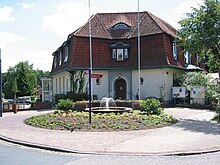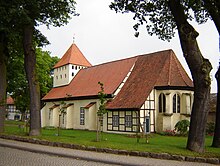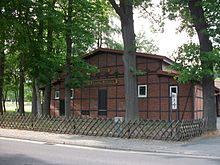Hankensbüttel
| coat of arms | Germany map | |
|---|---|---|

|
Coordinates: 52 ° 44 ' N , 10 ° 36' E |
|
| Basic data | ||
| State : | Lower Saxony | |
| County : | Gifhorn | |
| Joint municipality : | Hankensbüttel | |
| Height : | 95 m above sea level NHN | |
| Area : | 34.83 km 2 | |
| Residents: | 4520 (Dec. 31, 2019) | |
| Population density : | 130 inhabitants per km 2 | |
| Postal code : | 29386 | |
| Area code : | 05832 | |
| License plate : | GF | |
| Community key : | 03 1 51 011 | |
| LOCODE : | DE HBL | |
| Address of the municipal administration: |
Goethestrasse 2 29386 Hankensbüttel |
|
| Website : | ||
| Mayor : | Dirk Köllner ( CDU ) | |
| Location of the municipality of Hankensbüttel in the Gifhorn district | ||
Hankensbüttel is a municipality in the Gifhorn district in Lower Saxony . The municipality of Hankensbüttel is a member municipality of the joint municipality of Hankensbüttel , of which it is the administrative seat.
Geographical location
Hankensbüttel is located in Lower Saxony in the Gifhorn district. The closest cities are Wittingen , Uelzen , Celle , Gifhorn and Wolfsburg .
history
Historically, Hankensbüttel belongs to the group of Büttel localities. The first mention comes from a document from Emperor Heinrich III. from the year 1051, in which the place is evidently mentioned as "Honengesbuthele". At that time the Billunger family , followers of the Holy Roman Emperors , ruled the region. Located on important military and trade routes, it quickly developed favorably. Protection was provided by an aristocratic large court, which is believed to have existed as early as the 10th century, while a Conradus Honeskesbutle is documented as lord of the castle for the 13th century. As early as the 11th century, Hankensbüttel was the center of an extensive parish district and the seat of the episcopal sending court of the Diocese of Hildesheim . In the middle of the 12th century there was also a Gohgericht and a Gohgräfenhof. After the Billunger died out in 1106, the region came under the rule of the Guelphs , from 1267 on to the Lüneburg line.
During the Thirty Years' War Hankensbüttel was in the marching area of the fighting troops, at times the church was misused as an army camp and horse stable. In the 18th and 19th centuries, the place experienced the eventful history of the Hanover mansion. During the Seven Years' War (1756–1763), as during the time of the Kingdom of Westphalia (1807–1813 ), Hankensbüttel was under French rule, and from 1866 it belonged to Prussia . As a result of the Prussian district reform in 1885, Hankensbüttel, which at that time had around 1200 inhabitants, was incorporated into the newly created Isenhagen district, which was added to the Gifhorn district in 1933 . In 1904, Hankensbüttels was connected to the Celle – Wittingen railway line . Passenger traffic on this route was discontinued in 1974.
Since 1996 Hankensbüttel has been the administrative center of the municipality of the same name.
Origin of the place name
Old names of the place are 1051 Honengesbvthele, 1221 Honekesbutle, 1364 Honkesbutle and 1567 Hankensbüttel.
Formation from a personal name Honik or Honing, suffused short name. The short name Hon (i) is seen by Kaufmann as an abutment of the personal name stem han, plus asächs., Mnd. "Chicken". Hon in PN has the meaning "singer" according to Kaufmann. The short name is derived either with a strongly inflected k-suffix (see Barsbüttel) or, according to the first evidence, with -ing- (see Allingbüttel). Since -ing- generally also so or eastward. when -igg- appears and -eng- is only used twice, a k-suffix may be assumed. In the second part, Old Saxon (gi) butli "settlement".
Incorporations
On March 1, 1974, the parishes of Alt Isenhagen and Emmen were incorporated.
Population development
| year | Residents |
|---|---|
| December 1, 1905 | 1723 |
| June 16, 1925 | 2114 |
| June 16, 1933 | 2235 |
| October 29, 1946 | 4117 |
| June 6, 1961 | 4119 |
| May 27, 1970 | 3978 |
| December 31, 1989 | 3927 |
| December 31, 2009 | 4365 |
| December 31, 2010 | 4350 |
| December 31, 2011 | 4298 |
| December 31, 2015 | 4385 |
| December 31, 2017 | 4491 |
politics
Municipal council
The council of the municipality of Hankensbüttel consists of 15 councilors from the following parties:
| SPD | CDU | WGH | Green | FDP | Total seats | |
| 2001 | 2 | 7th | 2 | 2 | 2 | 15th |
| 2006 | 3 | 8th | 0 | 2 | 2 | 15th |
| 2011 | 4th | 7th | 0 | 2 | 2 | 15th |
| 2016 | 3 | 8th | 2 | 1 | 1 | 15th |
(As of July 2017)
mayor
The Mayor Dirk Köllner (CDU) since November 7, 2016 in the Official and thus replaced the previous mayor Martin Rausch (SPD). His deputies are Hinrich Schulze (CDU) and Rainer Nuth (SPD).
coat of arms
The design of the coat of arms of Hankensbüttel comes from the heraldist and coat of arms painter Gustav Völker , who also designed the coat of arms of Großburgwedel , Mellendorf , Wunstorf and many other localities. The approval of the coat of arms was granted on April 3, 1948 by the Lower Saxony Minister of the Interior .
| Blazon : "In Green by a silver wave beams diagonally left divided . In the middle of the coat of arms there is an upright golden sword , in the upper right flank a silver abbot's staff and in the lower left flank a silver horseshoe . " | |
| Justification of the coat of arms: The wave bar refers to the river Ise , which used to be the borderline between Gauen and later between the dioceses of Hildesheim , Verden and Halberstadt . The sword symbolizes the administrative and court seat of the former Gografschaft , the abbot's staff the place as a church center and the Isenhagen monastery . The horseshoe is reminiscent of a rest and relaxation area that was located on a road leading through the town. This north-south military road stretched from Lübeck to Innsbruck . |
flag
- The colors of the municipality of Hankensbüttel are green and silver (white).
Town twinning
Hankensbüttel has two city partnerships:
-
 Hainewalde , Saxony
Hainewalde , Saxony
-
 Le Mesnil-Saint-Denis near Paris, France (since 1984)
Le Mesnil-Saint-Denis near Paris, France (since 1984)
Culture and sights
In Hankensbüttel, the Otter Center has existed since 1988 on a six- hectare outdoor area, which is run by the association “Aktion Fischotterschutz e. V. "is operated. The facility is located directly on Lake Isenhagen.
Lake Isenhagen was artificially created in the 1960s by dredging. For several hundred years there were fish ponds of the nearby Isenhagen Abbey, which became a meadow in the 19th century.
The monastery Isenhagen in today Hankensbütteler district Isenhagen was built between 1345-1350 as a Cistercian monastery and since 1540 a Protestant convent . The monastery brewery with museum and a perennial and herb garden are open to the public.
The legendary preservation of the village during the Thirty Years' War is remembered at the Schweinemarkt . There are bronze sculptures of a small herd of pigs including a swineherdess. According to a local legend, the twelve-year-old swineherd Juliane Amalie Hinrichsen, known as “Püddelchen”, was woken up at night by the restlessness of her herd. As a result, they warned the place in good time of an attack by Wallenstein's (according to other tradition, Swedish) troops.
In the Musental, references to the musical tradition are interpreted spatially and sculpturally by artists. It is used for local recreation and events.
The community center redesigned with the founding of the Hankensbüttel community in 1996, in the typology of a former bourgeois town house, offers the clubs and citizens a conference room and a modern exhibition hall. It serves as a replacement for the former guest house , which became the otter center . The auditorium and cultural center have been missing since then.
St. Pancras Church
An exact date for the construction of the church is not known. However, it is certain that at the time of the first written mention of Hankensbüttel in 1051, the place was already the seat of a parish. Therefore it can be assumed that it was founded in the first millennium. The church is dedicated to a young martyr who was beheaded under the Roman emperor Diocletian (284–305). In accordance with its prominent importance, the structure of the church was very compact. The Romanesque hall building was surrounded by walls up to two meters thick and originally only had small-format windows. The compact tower was probably part of the building from the beginning. Presumably in the 15th century, the Romanesque vault was replaced by a Gothic vault, which, however, subsequently pushed the side walls up to 60 cm apart, so that they had to be supported with buttresses from the outside for stabilization. The ceiling vaults are decorated with paintings from the 15th and 18th centuries. A description can be found in Arno Schmidt's novel KAFF also Mare Crisium from 1960. The oldest inventory item is a triumphal cross carved from a piece of oak, which was probably made around 1230. The ring, which consists of seven bells, is one of the oldest in the region, as one bell was cast as early as 1250.
Regular events
- Wine festival , first weekend in August (even years)
- Heidmärker Festival , first weekend in August (uneven years)
- Potato Day , fourth weekend of August
- Trade show, third weekend in October
- Schützenfest , first full weekend in July (from the first Friday in July)
- Rock Against Violence, second or third Saturday in November
Clubs, associations and organizations
societies
- Aktion Fischotterschutz e. V., operator of the otter center Hankensbüttel
- Amnesty International eV Hankensbüttel
- Angelsportverein Hankensbüttel and surroundings e. V.
- Stage play club, amateur theater , carnival association
- Cochabamba Help for Bolivia e. V.
- FSV Nord eV Freizeit Sport Verein Nord
- Commercial association Hankensbüttel e. V.
- Kulturverein Hankensbüttel eV
- Rural Youth Hankensbüttel e. V.
- Music train Hankensbüttel
- Riding and Driving Association Hankensbüttel e. V.
- Rowing club at school Hankensbuettel e. V.
- Schützengesellschaft Hankensbüttel-Isenhagen e. V.
- SV Hankensbüttel from 1901 e. V.
Organizations
- Hankensbüttel volunteer fire department
- German Red Cross Hankensbüttel
- DLRG local group Hankensbüttel
Economy and Infrastructure
Establishments
In a 1972 built factory the company Lorenz Snack-World are potato chips and other snack products produced.
The Hankensbütteler Kunststoffverarbeitung GmbH & Co. KG has been producing plastic parts since 1972. Today the company is mainly a supplier for Volkswagen AG .
Crude oil has been produced in Hankensbüttel since 1954 .
education

- Optician school
- Specialized Academy for Ophthalmic Optics
- Karl Söhle Elementary School
- Hankensbüttel high school
- School center with branch of the grammar school and the secondary school (former orientation level)
Personalities
Sons and daughters of the church
- Gerhard Drees (1925–2015), civil engineer, university professor and entrepreneur
- Peter Sakuth (* 1948), administrative officer, entrepreneur and politician (SPD)
- Manfred Strossenreuther (1948–1986), sports pilot and multiple world and European champion in aerobatics
- Eckhard Lucius (1954–2011), biology didactic at the Leibniz Institute for Science and Mathematics Education (IPN) at the University of Kiel
- Cornelia Vismann (1961–2010), legal historian, media theorist and philosopher
People connected to the community
- Gustav Vogel (1843–1901), high school teacher, private tutor in Hankensbüttel
- Georg von Eucken-Addenhausen (1855–1942), lawyer and politician, trainee lawyer in Isenhagen
- Karl Söhle (1861–1947), writer, spent childhood and youth in Hankensbüttel
- Hans von Lüpke (1866–1934), liberal Lutheran theologian and publicist as well as a leader in the German village church movement, pastor in Isenhagen (1919)
- Erich Hoyer (1880–1943), pastor in Isenhagen, died in Isenhagen
- Otto Haesler (1880–1962), architect, representative of the Bauhaus and for New Building, Celle and Rathenow, professor of housing construction, architect of the Karl Söhle School
- Otto Gakenholz (1890–1973), postmaster in the imperial postal service in Isenhagen-Hankensbüttel, politician (NSDAP)
- Johannes Schulze (1901–1980), Evangelical Lutheran theologian, pastor in the St. Pankratius Church in Hankensbüttel
- Heinrich Warnecke (1923–1995), politician (CDU) and member of the Lower Saxony state parliament, chairman of the supervisory board of the agricultural buying and selling cooperative in Hankensbüttel
- Georg Arfmann (1927–2015), sculptor, created the bronze group of pigs with girls (1991) in Hankensbüttel
- Dietmar Cordan (* 1941), tenor and opera singer, author, was 'discovered' in Hankensbüttel
- Klara Butting (* 1959), Protestant theologian, university professor and author, went to school in Hankensbüttel
literature
- Horst Appuhn: Pictures from Isenhagen Abbey . Königstein im Taunus 1989, ISBN 3-7845-0480-9 (= The Blue Books)
- Günter Dickmann: Integrated community of Hankensbüttel. The 20th Century: Memories in Pictures. Ed .: Samtgemeinde Hankensbüttel, Hankensbüttel 2000
- Joachim Lücke: Church leader of the Ev.-luth. St. Pankratius Church in Hankensbüttel. Ed .: Ev.-luth. Hankensbüttel parish, specialist publisher EK Service Saarbrücken, 2006
Web links
Individual evidence
- ↑ State Office for Statistics Lower Saxony, LSN-Online regional database, Table 12411: Update of the population, as of December 31, 2019 ( help ).
- ^ Jürgen Udolph (research): The "place name researcher". In: website NDR 1 Lower Saxony. Archived from the original on November 27, 2015 ; accessed on April 7, 2018 .
- ^ Federal Statistical Office (ed.): Historical municipality directory for the Federal Republic of Germany. Name, border and key number changes in municipalities, counties and administrative districts from May 27, 1970 to December 31, 1982 . W. Kohlhammer, Stuttgart / Mainz 1983, ISBN 3-17-003263-1 , p. 227 .
- ↑ Excerpt - Election of the mayor. In: Website of the joint municipality of Hankensbüttel. November 7, 2016, accessed January 13, 2018 .
- ↑ The mayor and his deputies. (No longer available online.) In: Website of the Samtgemeinde Hankensbüttel. Formerly in the original ; accessed on April 7, 2018 . ( Page no longer available , search in web archives ) Info: The link was automatically marked as defective. Please check the link according to the instructions and then remove this notice.
- ↑ District of Hanover: Wappenbuch district of Hanover . Published by the author himself, Hanover 1985.
- ^ A b Arnold Rabbow: Braunschweigisches Wappenbuch . The coats of arms of the communities and districts in the urban and rural districts of Braunschweig, Gandersheim, Gifhorn, Goslar, Helmstedt, Peine, Salzgitter, Wolfenbüttel and Wolfsburg. Ed .: Braunschweiger Zeitung, Salzgitter Zeitung and Wolfsburger Nachrichten. Eckensberger & Co Verlag, Braunschweig 1977, DNB 780686667 , p. 122 .
- ↑ Entry about the partner community on the homepage of the community Hankensbüttel.Retrieved on April 16, 2019, 10:48 pm
- ↑ Kulturverein Hankensbüttel eV In: Website of the Samtgemeinde Hankensbüttel. Retrieved October 29, 2018 .














